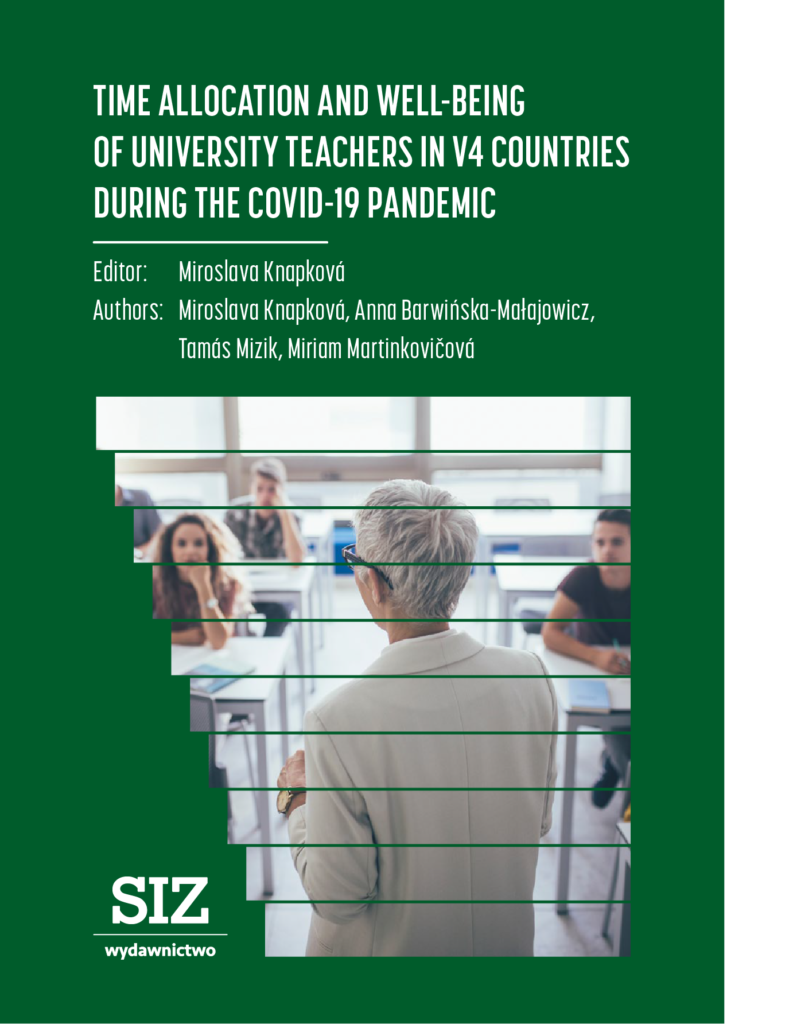
Time Allocation and Well-Being of University Teachers
in V4 Countries During the Covid-19 Pandemic
| E-ISBN | 978-83-65766-75-5 |
| Rok wydania | 2022 |
| Wydawnictwo | Wydawnictwo SIZ |
| Liczba stron | 160 |
| Wolny dostęp | Link |
Spis Treści
Acknowledgement
Preface
Supporter of the Project
Authors
Introduction
1. Theoretical background of time allocation and well‑being
1.1. Scientific reflection on time and its allocation
1.2. Time allocation and well‑being
1.3. Time allocation and well‑being of university teachers
2. Possibilities of measuring time allocation and well‑being
2.1. Methods of detecting and measuring time allocation
2.2. Well‑being and possibilities of its measurement
2.2.1. Approaches to measuring well‑being
2.2.2. Time diary and well‑being measurement
2.2.3. Measuring positive and negative emotions (affect)
3. Time allocation and Well‑being research during Covid–19 pandemic
3.1. Online teaching before COVID–19 era
3.2. Research of well‑being under COVID–19 pandemic
3.2.1. Methods of data collecting during COVID–19 pandemic
3.3. Innovative data collection method – CaDDI
3.4. Research on the teachers’ wellbeing during COVID–19 period
4. Specifics of the labour market and the nature of work of university teachers in the V4 countries
4.1. Specifics of university teachers‘ labour market – global perspective
4.2. Teachers’ labour market in V4 countries
4.3. Specifics of teachers´ labour market in Slovakia
4.3.1. Overview of Slovak higher education system
4.3.2. Specifics of employment contracts of higher education teachers in Slovakia
4.4. Specifics of teachers’ labour market in Poland
4.4.1. The Polish labour market – general characteristics
4.4.2. Specifics of the labour market of university teachers in Poland
4.4.3. The labour market of academic teachers – selected information and statistic data
4.5. Specifics of teachers’ labour market in Hungary
4.5.1. Overview of Hungary’s higher education system
4.5.2. Characteristics of higher education in Hungary
4.5.3. Impacts of the COVID–19 pandemic with special attention paid to Hungarian higher education
5. Time allocation and well‑being of university teachers in V4 countries
5.1. Aim and methodology
5.1.1. Time allocation section of the questionnaire
5.1.2. Feelings section in the questionnaire
5.2. Descriptive statistics
5.2.1. Slovakia
5.2.2. Poland
5.2.3. Hungary
5.2.4. Czech Republic
5.3. Time allocation of V4 university teachers
5.4. Well‑being of V4 university teachers
6. Conclusions, summary and future direction of research
References
List of Figures
List of Graphs
List of Tables